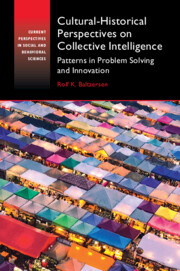 Cultural-Historical Perspectives on Collective Intelligence
Cultural-Historical Perspectives on Collective Intelligence Book contents
- Cultural-Historical Perspectives on Collective Intelligence
- Current Perspectives in Social and Behavioral Sciences
- Cultural-Historical Perspectives on Collective Intelligence
- Copyright page
- Dedication
- Contents
- Figures
- Tables
- Chapter 1 What Is Collective Intelligence?
- Chapter 2 Crowdsourcing
- Chapter 3 Open Online Knowledge Sharing
- Chapter 4 Human Swarm Problem Solving
- Chapter 5 The Origins of Human Swarm Problem Solving
- Chapter 6 Human Stigmergic Problem Solving
- Chapter 7 The Origins of Human Stigmergic Problem Solving
- Chapter 8 Collaborative Problem Solving
- Chapter 9 The Origins of Collaborative Problem Solving
- Chapter 10 Intelligent Engagement
- Chapter 11 Intelligent Contributions
- Chapter 12 Intelligent Evaluations
- Chapter 13 COVID-19 as a Wicked Problem
- Chapter 14 Motivation to Contribute
- Chapter 15 The Intelligent Society
- References
- Index
- References
References
Published online by Cambridge University Press: 03 February 2022
- Cultural-Historical Perspectives on Collective Intelligence
- Current Perspectives in Social and Behavioral Sciences
- Cultural-Historical Perspectives on Collective Intelligence
- Copyright page
- Dedication
- Contents
- Figures
- Tables
- Chapter 1 What Is Collective Intelligence?
- Chapter 2 Crowdsourcing
- Chapter 3 Open Online Knowledge Sharing
- Chapter 4 Human Swarm Problem Solving
- Chapter 5 The Origins of Human Swarm Problem Solving
- Chapter 6 Human Stigmergic Problem Solving
- Chapter 7 The Origins of Human Stigmergic Problem Solving
- Chapter 8 Collaborative Problem Solving
- Chapter 9 The Origins of Collaborative Problem Solving
- Chapter 10 Intelligent Engagement
- Chapter 11 Intelligent Contributions
- Chapter 12 Intelligent Evaluations
- Chapter 13 COVID-19 as a Wicked Problem
- Chapter 14 Motivation to Contribute
- Chapter 15 The Intelligent Society
- References
- Index
- References
Summary
- Type
- Chapter
- Information
- Cultural-Historical Perspectives on Collective IntelligencePatterns in Problem Solving and Innovation, pp. 419 - 441Publisher: Cambridge University PressPrint publication year: 2022
- Creative Commons
- This content is Open Access and distributed under the terms of the Creative Commons Attribution licence CC-BY-NC-ND 4.0 https://creativecommons.org/cclicenses/
